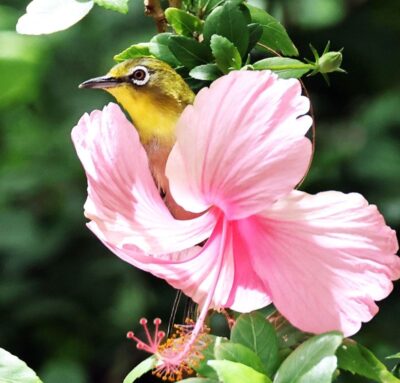
Warbling Their Way to Happiness
/ Bird News, General Updates / By
Susan Scott
10 things we want to share about the Warbling White-eye (Mejiro)
- In 2018, researchers changed this bird’s English name from Japanese White-eye to Warbling White-eye.
- Researchers have identified 15 subspecies (so far) of Warbling White-eyes, native to Japan, Indonesia, the Philippines, Korea, and far east Russia.
- Most Hawaiʻi residents know the bird by its Japanese name, mejiro. In Japanese, me means eye; shiro/jiro means white.
- In 1929, the Hawaiʻi Board of Agriculture and Forestry imported the first Warbling White-eyes from Japan to Oʻahu to eat insect pests. Introductions continued through 1937.
- The birds spread throughout the main Hawaiian Islands on their own and are now abundant in both wet and dry areas, from sea level to tree line.
- Warbling White-eyes eat insects, fruit, and nectar.
- On Oʻahu, the birds feed in over 30 tree speciesfor fruit and nectar. In native forests, white-eyes visit ʻōhiʻa and māmane trees for insects and nectar.
- On the plus side, researchers have reported this songbird visiting the flowers of the endemic lobelioid, ʻōhā wai nui (Clermontia arborescens), the bird perhaps acting as a pollinator to some native plants.
- On the minus side, white-eyes compete with native forest birds for nectar and spread seeds of unwanted nonnative plants, such as lantana and banana poka.
- Warbling White-eyes are widespread throughout the main Hawaiian Islands, but at only four inches tall, and constantly flitting about in trees, the greenish birds can be hard to see.
